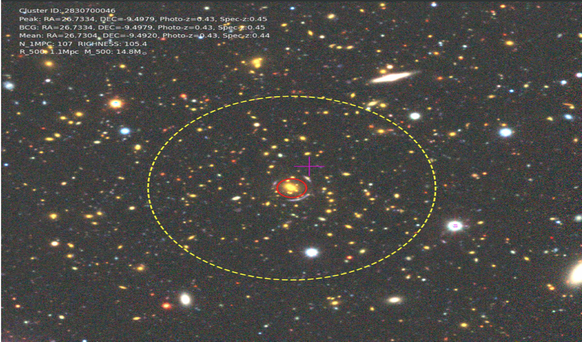Apr 20 2021
Galaxy clusters, the most enormous gravitationally bound systems found in the universe, include a huge number of galaxies and lots of dark matter and gas.
 One of the detected clusters at the redshift of about 0.4. Some properties of the cluster and the brightest cluster galaxy (BCG) are displayed. The position of the BCG is marked by the small circle, the average position of the member galaxies by the cross, and the distance of 0.5 Mpc from the BCG by the big circle. Image Credit: NAOC.
One of the detected clusters at the redshift of about 0.4. Some properties of the cluster and the brightest cluster galaxy (BCG) are displayed. The position of the BCG is marked by the small circle, the average position of the member galaxies by the cross, and the distance of 0.5 Mpc from the BCG by the big circle. Image Credit: NAOC.
They are the perfect laboratories for the exploration of the formation and evolution of galaxies in dense environments. They also serve as brilliant probes for investigating the large-scale structure, dark energy, and dark matter.
A huge galaxy cluster sample at z < 1, when the universe was nearly 5.7 billion years old, forms the basis for accurate analysis of the late evolution of galaxies in a dense environment, specifically in the case of brightest cluster galaxies (BCGs).
A team of scientists headed by Dr Hu Zou from the National Astronomical Observatories of the Chinese Academy of Sciences (NAOC) recently used the deep imaging data obtained from the Dark Energy Spectroscopic Instrument (DESI) imaging surveys and identified over 540,000 galaxy clusters at z < 1. These clusters are the largest sample found so far.
The study findings were published on April 13th, 2021, in The Astrophysical Journal Supplement Series.
The galaxy clusters identified in this study will be used for further analysis of the properties of member galaxies, mass assembly and star formation in a dense environment, the evolution of enormous central galaxies, gas properties in clusters, etc.
Thanks to international collaboration, Dr Hu Zou was part of the DESI project and performed large-scale multi-wavelength imaging surveys, such as the Beijing-Arizona Sky Survey (BASS).
Before the researchers can use the imaging data to identify galaxy clusters, they have precisely calculated the photometric redshifts and stellar masses of around 300 million galaxies with r < 23, almost six million times fainter when compared to the stars that can be seen by the human eyes.
By using the photometric redshift catalog as the basis, the researchers employed a new fast peak clustering algorithm and identified over 540,000 galaxy clusters consisting of more than 10 members.
Contrary to the cluster finders relying on red sequence, the team could identify even those clusters that lacked red galaxies. When compared to conventional overdensity identifying techniques, the speed performance of the new technique is superior and enables member galaxies to be detected easily. Furthermore, the researchers have initially detected over a hundred strong lensing systems in these clusters.
This study will have a crucial role in data analyses and scientific investigations of future Chinese large telescopes and large-scale surveys, for example, the Chinese Space Station Telescope (CSST).
Journal Reference:
Zou, H., et al. (2021) Galaxy Clusters from the DESI Legacy Imaging Surveys. I. Cluster Detection. The Astrophysical Journal Supplement Series. doi.org/10.3847/1538-4365/abe5b0.